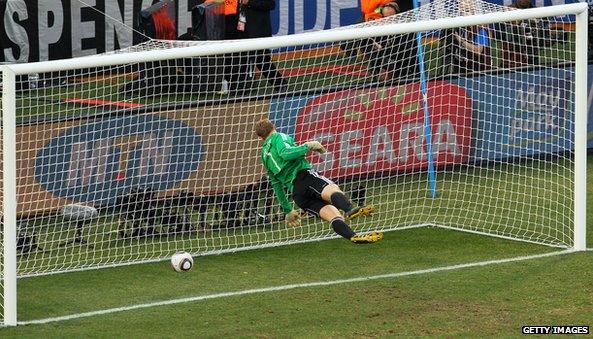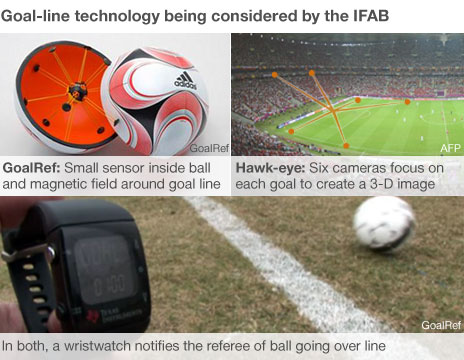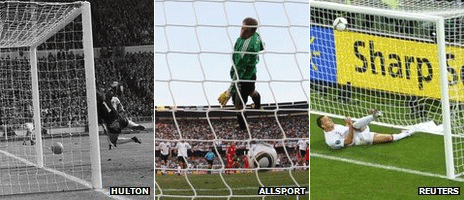England v Germany: Goal-line technology decision imminent
- Published
- comments

Goal! It was this effort, from England's Frank Lampard, that set the ball rolling for Thursday's vote on goal-line technology
Football's world governing body Fifa and other organisations are preparing to vote on something many fans of the game have been crying out for: goal-line technology (GLT).
For years, supporters have watched, heads in hands, as balls bounced over the line - only for the referee and his assistants to somehow be the only people in the stadium not to see the clear goal.
Meanwhile, other sports like tennis, cricket and rugby have all embraced technology to assist officials in making the right decisions.
But in football, the powers-that-be have always been reluctant. Fifa's outspoken president Sepp Blatter said he didn't want to slow the game down or make it less exciting.
In Europe, Uefa president Michel Platini has been equally hesitant, instead pressing ahead with the largely unpopular introduction of extra officials near the goal-line - an addition viewed by many as useless.
One such official was described by a television pundit as "just a bloke with a silly wand".
But a shot by England's Frank Lampard during a World Cup match versus Germany in 2010 meant Fifa had no choice but to reconsider.
It was clear - to everyone except the officials - that it had crossed the line.
The wheels were finally set in motion to make GLT part of the beautiful game - and on Thursday football chiefs will decide which technology will be given the green light.
Hawk-Eye vs Goalref
In 2011 Fifa <link> <caption>released a document outlining the criteria</caption> <url href="http://www.fifa.com/mm/document/affederation/administration/01/42/87/09/11.05.03_ifab_glt_specifications_en.pdf" platform="highweb"/> </link> which the technology must meet:
Accuracy must be 100% - with no concessions made for shots that, for example, hit the side netting and bulge into the goal.
The referee must be notified of the goal within a second of it crossing the line, as any longer would disrupt the flow of the match.
And the technology must be able to work both during the day and at night under floodlights, and in all weather conditions.
Of 12 initial candidates, just two companies made the cut. And, fittingly enough, it's England versus Germany all over again.

From Germany: Goalref, a system which relies on a customised ball with a special sensor in the middle.
When the ball crosses the line it disrupts a magnetic field, and the referee is told almost instantly.
England's offering is Hawk-Eye, a technology that will be familiar to many sports fans thanks to its widespread adoption in tennis and cricket.
It is a camera-based system; six for each goal, set up in various parts of the ground. When combined they can pinpoint exactly where the ball is. Like Goalref, the referee is then informed immediately via a wristwatch.
Drama vs cost
A simple choice between in-the-ball or in-the-stands tech then? Not quite.
The vote, to be hosted by the International Football Association Board (IFAB) - of which Fifa represents 50% of the vote - is about a lot more.
For instance, Hawk-Eye relies on more than 25% of the ball being visible to its cameras. A messy goalmouth scramble could stop it working.
But the Hawk-Eye method brings great "was it in?!" drama, and while Goalref can merely tell the referee and supporters that the ball has gone in, Hawk-Eye can provide documented evidence of the fact via an instant virtual-reality replay.

England's drama: (L-R) dubiously awarded a goal in 1966; denied a clear goal in 2010; and lucky not to concede against Ukraine this summer
But Goalref has a trump card: cost. The system itself is easier and cheaper to install than Hawk-Eye, and doesn't require any extra surrounding structures to which to attach cameras.
It means it is far more likely that Goalref could be used in almost any significant football league.
There is a chance, Fifa told the BBC, that both systems could get the IFAB's backing.
It would mean leagues across the world could decide to adopt either system - with the most likely scenario being that the top divisions, such as the Premier League, would go for Hawk-Eye, with Goalref adopted in the lower leagues to keep costs down.
Uefa protests
Whichever they choose, it will mean that leagues finally have got the green light for the technology to be rolled out. It will be too soon for the upcoming Premier League season, officials said, but by 2013-2014 we could see it in action around the UK's stadiums.
The first major league to take it up could be the US Major League Soccer - home to David Beckham - which kicks off its next season in March.
However, one league we're unlikely to see technology at in the near future is the Champions League, despite it being host to several controversial goal-line incidents.
Such is Uefa president Michel Platini's disdain for GLT, he has called for Fifa to postpone Thursday's decision and instead "start an open debate about technology in football".
"I am wholly against goal-line technology," the Frenchman said.
"But it's not just goal-line technology. I am against technology itself because it will invade every single area of football."
At the time of writing, Fifa has told the BBC that the vote is still set to go ahead despite Uefa's protests - but that could potentially change at the last minute.
Additionally, the members of the IFAB panel could vote for neither option - sending the process back to the drawing board.
Should that happen, it will no doubt be seen by most fans worldwide as one of world football's biggest own goals to date.
- Published16 May 2012